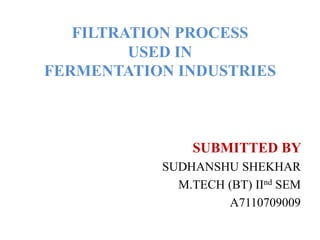
Bioprocess Presentation
- 1. Filtration process used in fermentation industries SUBMITTED BY SUDHANSHU SHEKHAR M.TECH (BT) IInd SEM A7110709009
- 2. Filtration: INTRODUCTION Filtration is a mechanical or physical operation by which solid particles are separated from a fluid-solid mixture by forcing the fluid through a filter medium or filter cloth. It is one of the most common processes used at all scales of operation to separate suspended particles from a liquid or gas through a porous substance called “filter”. Example(s):Fine particles, Microbes, Polymer molecules, Mist, Aerosol, etc.
- 3. FILTRATIONS DEPENDS UPON: Viscosity and density of the fluid: Viscosity describes a fluid's internal resistance to flow and may be thought of as a measure of fluid friction. Unit: Pa-s (N·m−2·s) The nature of the solid particles, particularly their size and shape distribution Aseptic conditions: Aseptic conditions is essential to avoid undue contamination and degradation of labile (becoming inactive when subjected to heat or radiation) products.
- 4. Cake Filtration A filter cake is formed by the substances that are retained on a filter. The filter cake grows in the course of filtration, becomes "thicker" as particulate matter is being retained. Due to the deposition of solids, the thickness of filter cake is increased and so it make a constraint to further filtration. Diagram of a simple filtration apparatus
- 5. When filter cake is deposited heavily, it is removed from the filter by back flushing. This is essential to avoid disruption because when the flow resistance of the filter cake gets too high, then too little of the mixture is filtered through the filter cake and the filter plugs.
- 6. The rate of flow of filtration process is given by the following equation: Where, µ= liquid viscosity L= depth of filter bed P= pressure differential across the filter bed A= area of filter exposed to the liquid K= constant of the system
- 7. Filter Aid “Filter Aids” is a group of inert materials that can be used in filtration pretreatment. Filter aids are used when filtering bacteria or other fine or gelatinous substances which prove slow to filter or particularly block a filter. Filter aidssuch as diatomaceous earth have found widespread use in the fermentation industry to improve the efficiency of filtration.
- 8. OBJECTIVES OF ATTACHING FILTER AID To form a layer of second medium which protects the basic medium of the system. This is commonly referred to as “precoat”. To improve the flow rate by decreasing cake compressibility and increasing cake permeability. This type of usage is termed as “admix” or "body feed".
- 9. (a)Filter without filter aid; (b) Filtration with “Precoat” and (c) Filter with “admix” or "body feed".
- 11. factors of filtration Filtration efficiency: Filtration efficiency is the ratio of the upstream suspended solids concentration compared to the downstream suspended solid concentration which has passed through the filter. Flow rate: The flow rate is the volume or weight of the fluid which has passed through the filter at the unit area at the unit time. Filtration life: The life of the filter is the time it takes until the filter becomes clogged with particles and other suspended matter so that it can no longer function at a certain flow volume.
- 12. Filter media There are three main types of filter media employed in the filtration process: Surface filtration: This filtration mechanism mainly retains particulate matter from the fluid on the surface of the filter. Depth filtration: This filtration mechanism retains particulate matter not only on the surface of the filter but also at the inside of the filter. Cake filtration: By this filtration mechanism, the cake accumulated on the surface of the filter is itself used as a filter.
- 13. FILTERS USED IN FERMENTATION PROCESS BATCH FILTER Plate and Frame Filters: A plate and frame filter is a pressure filter in which plates and frames are arranged alternately. The plates are covered with filter cloths or filter pads. The plates and frames are assembled on a horizontal framework and held together by means of a hand screw or hydraulic ram so that there is no leakage between the plates and frames which form a series of liquid-tight compartments. Assembly of plate and frame filter
- 14. Plate filtersare suitable for filtration of small fermentation batches; this type of filter gradually accumulates biomass and must be periodically opened and cleared of filter cake. DISADVANTAGE Because of high labor costs and the time involved in dismantling, cleaning and reassembly, these filters should not be used when removing large quantities of worthless solids from a broth.
- 15. CONTINUOUS FILTER Rotary Vacuum PrecoatFilters: Rotary Vacuum Precoat Filters are typically used for thick, difficult to filter liquids or when the solids content is high. It is the most widely-used filtration devices in the fermentation industry because of large volumes of liquid need continuous processing.
- 16. Rotary Vacuum Precoat Filters
- 17. THANK YOU